Abstract
The remote sensing-based Earth satellites has become a beneficial instrument for the monitoring of natural hazards. This study includes a multi-sensors analysis to estimate the spatial-temporal variations of atmospheric parameters as precursory signals to the Mw 7.2 Haiti Earthquake (EQ). We studied EQ anomalies in Land Surface Temperature (LST), Air Temperature (AT), Relative Humidity (RH), Air Pressure (AP), and Outgoing Longwave Radiation (OLR). Moreover, we found EQ-associated atmospheric abnormalities in a time window of 3–10 days before the main shock by different methods (e.g., statistical, wavelet transformation, deep learning, and Machine Learning (ML)-based neural networks). We observed a sharp decrease in the RH and AP before the main shock, followed by an immense enhancement in AT. Similarly, we also observed enhancement in LST and OLR around the seismic preparation region within 3–10 days before the EQ, which validates the precursory behavior of all the atmospheric parameters. These multiple-parameter irregularities can contribute with the physical understanding of Lithosphere-Atmosphere-Ionosphere Coupling (LAIC) in the future in order to forecast EQs.
1. Introduction
The Earthquake (EQ) events significantly impacts the Earth’s atmosphere by the incorporation of abrupt energy from the epicentral regions within the seismic preparation zone. Several studies have reported EQ-associated anomalies not only on the surface of the Earth, but also from different satellites in atmosphere during the period of seismic preparation [1,2,3]. EQ precursors from space-based observations have provided deep insights and emerged as a useful tool for investigating possible anomalies of EQ activity over the epicenter region. On the other hand, the space-based EQ anomalies offered more benefits for main shock observation than the other conventional methods of EQ precursors from ground measurement [4,5]. For analogy, the stations monitoring EQ on the ground are quite scarce as compared to satellite-based surveillance of seismic events. For instance, thermal remote sensing in EQ investigation using high resolution temporal datasets has achieved unusual improvements [6,7,8]. These precursors can be categorized into three classes based on their altitude around the epicenter and the time range of massive EQs. The first class is on the surface, which includes LST and AT, followed by the second class of atmospheric variables, RH, AP, and OLR. Finally, the third form of the EQ precursors appear in the ionosphere, such as total electron content, electron density, and plasma temperature [9,10].
EQ precursors and the possibility of making a prediction have a long history, with some successful instances for monitoring the 1975 Haicheng Mw 7.3, China event [11]. Moreover, several theories have been hypothesized to describe the EQ precursors. For example, Pulinets et al. [12] hypothesized that the cycle of energy flows provoked by the supply of radon in the atmosphere, and this hypothesis is endorsed by many scientists [13,14,15,16]. Radon decay in the atmosphere ionizes the air, triggering surface temperature increment and a drop in humidity, and eventually causes disturbances in the atmosphere [17]. Another source of EQ precursors is the mechanism of positive holes (p-holes) developed around stressed rocks beneath the hypocentral depth, where the p-holes are distributed around the epicenter and associated fault lineaments [18]. The more and more p-holes evacuate straight up into the atmosphere after a threshold until the EQ main shock day, which further ionizes the atmosphere [3]. After all these hypotheses regarding EQ precursory parameters, EQ prediction has still not been presented by anyone to date. Recent research has shown that intelligent machine learning techniques can be useful in modeling these nonlinear behaviour patterns in EQ precursor studies. Ensembles methods (Decision Tree, Bagging, Boosting, and Random Forest), Support Vector Regression (SVR), optimization algorithms, and Artificial Neural Network (ANN) are examples for time series modeling of precursor signals [6,19]. Additionally, Earth’s observation of satellite data in EQ studies with a powerful deep learning techniques can confidently develop an early warning systems with high precision.
In the paper, we investigated the synchronized phenomena of multiple atmospheric disturbances associated with the Haiti EQ of Mw 7.2 on 14 August 2021, in order to find out a specific time window of the occurrence of atmospheric precursors by scaling the anomalies using statistical and machine learning approaches. The main objectives of the current study are to statistically find a time window for EQ precursors in LST, AT, RH, AP, and OLR, and to validate and confirm the existence of seismically induced atmospheric anomalies by wavelet transformation and Machine Learning (ML) algorithms. Furthermore, more analyses were conducted in the current study in order to clarify the EQ-induced atmospheric anomalies.
2. Study Area
A study of the temporal and spatial variations for multiple atmospheric parameters is presented for the Mw 7.2 Haiti EQ and its surrounding tectonic settings, as in Figure 1. The main shock occurred on 14 August 2021, 12:29:08 (UTC), along the oblique reverse motion across the Enriquillo–Plantain Garden Fault Zone (EPGFZ), at 125 km west of Port-au-Prince, Haiti’s capital.
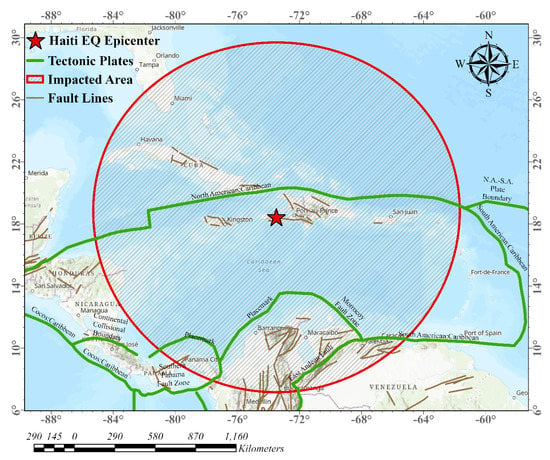
Figure 1.
Geographical location map of the 2021 Mw 7.2 Haiti EQ (Lat = 18.43° N, Long = 73.48° W) with major faults. The epicenter is indicated by a red-filled star along with the fault lines in Haiti, where the red circle is the Dobrovolsky region [20].
A reverse fault striking west and heading north with a component of left-lateral slip, as well as a fault knocking southeast and heading southwest with a right-lateral slip, caused the EQ at a shallow depth of 10 km. As the Caribbean plate moves left-laterally relative to the North American plate, the plate boundary in this seismic region adapts eastward. Based on this analysis, an east-west striking and north-dipping fault plane with left-lateral slip is likely to be the source of this EQ. Houses, hospitals, and schools have been destroyed, and over 2200 deaths have been reported. More information about this EQ can be found on the USGS website [21].
3. Materials and Methods
3.1. Data Collection
This study examines the multi-parameter pre-seismic atmospheric anomalies of the Haiti EQ in the seismic preparation zone over the epicenter. In this study, we analyzed the LST, AT, RH, AP, and OLR for monitoring the atmospheric anomalies. In order to validate the abnormalities linked with the seismic zone, daily LST images were retrieved from MODIS. The MODIS was launched on board the Terra satellite on 19 December 1999 to observe the terrestrial ecosystems, oceans, and global atmosphere [7,22,23]. At the satellite nadir, MODIS LST images have a spatial resolution of one kilometer for each of the three infrared bands (29, 31, and 32) [9]. We analyzed the LST images assembled as MOD11A1 (V6), which was retrieved from the USGS Earth Explorer, for three months before and three months after the main shock of the 2021 Haiti EQ. These MODIS images have daily emissivity and LST measurements. The missing LST values under the cloud cover are estimated over the epicenter using the Random Forest technique [24]. The other parameters of the atmosphere (AT, RH, AP, and OLR) are also studied in this paper in order to provide more evidence to support the MODIS analysis associated with the seismic activity, similarly to previous authors [2,17]. The AT, RH, AP, and OLR data are retrieved from the NCEP/NCAR reanalysis project [25].
3.2. Data Analysis
The precursory study is conducted within an effective area around the epicenter during the EQ preparation process, where the epicenter is the pivotal point [20].
In above equation, M represents the magnitude of the EQ, and the radius of the preparation zone is represented by . In accordance with the formula, the Haiti EQ has an epicentral zone of 1247 km, which is elongated from 8° to 28° north along latitude and 63° to 84° west along longitude. The EQ preparation zone includes the region of ±10° in latitude and longitude around the epicenter, where all spatial and temporal datasets were retrieved.
In order to take account of the fact that the nonlinear time series values fluctuate and do not satisfy a Gaussian probability function, several researchers use the interquartile range (IQR) and the median methods [26]. The interquartile range defines the upper and lower bounds to perceive seismic anomalies from the normal distributions of the time series. Following are the equations to calculate the upper and lower bounds of the atmospheric time series.
where, x, , , and represent the original atmospheric parameters: upper bound, lower bound, median, interquartile ranges, and differential of x, respectively. In this case, the performance of the relevant parameter () is regarded as anomalous if its absolute value is greater than , (|| > ). Based on Equation (4), if any of the atmospheric parameters vary from the normal distribution as indicated by , we can say with a significance level of about 80–85% that the lower or higher abnormal signal has been identified. Similarly, if a time series data point falls out beyond either lower or upper bound, it is known as anomalous EQ event [1]. In this paper, the upper and lower bounds are calculated from the median and IQR of all the values before and after the main shock day.
In this study, we also employed the wavelet transformation functions on the different time-series data to find irregularities in the atmospheric parameters as an anomaly associated with the EQ.
Here, a wavelet dilation is represented by scale and represents wavelet translation , while the complex conjugate of the mother wavelet is represented by () is (), and the coefficient indicates the energy standardized factor. The wavelet scale changed smoothly over time, and a scalogram was produced as a translation factor. For the Haiti EQ time series datasets, M + 1.6*SD has been selected as the optimal threshold value to identify an unusual value, where M and SD are mean and standard deviation, respectively. In wavelet analysis, the time series with wavelet coefficients that exceed the threshold values are referred to as anomaly series [27].
In order to confirm the existence of atmospheric anomalies associated with Haiti EQ, a nonlinear autoregressive with exogenous inputs (NARX) network is also employed in this study. NARX is a class of artificial neural networks to signify a nonlinear dynamic time series system [6]. The time series are modeled using the NARX network architecture, with the dependent output signal estimation being regressed against both the independent input signal and the output signal. The NARX architecture is shown below.
The output, input lags, the number of hidden layers, the corresponding neurons, the activation functions, and the learning algorithm were acquired iteratively in order to establish the network architecture and minimize estimation error during training. In both the hidden and output layers, the linear and sigmoid activation functions specify the optimal outcomes. Due to concerns with the function approximation, the Levenberg–Marquardt algorithm offered networks with hundreds of weights enabling quicker convergences [28]. The Levenberg–Marquardt optimization algorithm is utilized in this study for training purposes.
Furthermore, N observations have been incorporated into the prediction process, including the following observations: and , which are chosen for training and test sets, respectively. In this study, a projected network was constructed consisting of six nodes in the input layer, ten in the first and second hidden layers, and one in the output layer. Furthermore, the observed time series values, respective time, and deviation of observed time series data from the mean distribution are considered as inputs. A time series of daily values are displayed within the Dobrovolsky region as the output layer. The following are the proposed training patterns for networks.
As part of the prediction process, the following equation is used to determine optimized weights in order to minimize the prediction error (PE).
In Equation (10), represents the output of the network. The below equations are used for testing the data.
Finally, anomalies are identified by evaluating deviations between predicted and actual values beyond predefined boundaries.
Hochreiter and Schmidhuber [29] developed a long Short-Term Memory (LSTM) algorithm in 1997 to overcome the vanishing gradients in the recurrent neural networks (RNNs). In this method, by utilizing the shared parameters as the data moves forward, the network captures the vibrant temporal behavior within time series data. LSTM incorporates some units, entitled memory blocks, in its recurrent hidden layers, which maintain short- and long-term values using memory cells to provide information about self-connections and the network’s temporal state [30]. The LSTM comprises three layers, but a hidden layer controls for the movement of information to the memory cells through three units (input, forget, and output). According to the activation level of each unit, the information dwelling in memory is stored within the memory cell (in case of high input activation), and passed on to the next neuron (in the case of high output activation), and cleared (in the case of high output activation). The mathematical formulation of the functions of the three units is below.
At time step , Equations (15)–(18) illustrate a forget unit, an input unit, an output unit, a current memory cell, and a hidden unit. In terms of kernel functions, they are represented by and . For three memory units and memory cells, W and b represent the weight matrix and bias variables, respectively. The addition of three units depicts the previously hidden unit as Current cell unit is denoted as after processing. In hidden layers, the multiplication of elements between input, cell, and output units is indicated by .
Following the LSTM learning, the parameters of LSTM are tuned according to the state matrix pattern. The LSTM approach is proposed as part of this study, which divides each time series into 70% for training and the remaining 30% for testing and anomaly detection. Based on the testing data, values were predicted by LSTM, and the deviation between the predicted and observed values were computed. An anomalous day was detected if these differences were beyond the predefined bounds. Training and application of the method were conducted separately for each time series. For the Haiti EQ time series datasets, M + 1.6*SD were selected as the bounds to identify an unusual value in LSTM time series, where M and SD represented mean and standard deviation, respectively. In wavelet analysis, the time series with wavelet coefficients that exceeded the threshold values were referred to as anomaly series [27]. After an anomaly’s detection beyond the bounds, the correlation analysis of both the original and predicted values for both NARX and LSTM algorithms was performed by the Pearson correlation equation.
where is the correlation value for the (predicted NARX and LSTM) and (observed NARX and LSTM) values with their mean values ( and ).
4. Results and Discussion
4.1. Anomalies Evidence
In this paper, we analyzed multiple atmospheric anomalies through different statistical and machine learning procedures for synchronization with the 2021 Mw 7.2 Haiti EQ.
From Figure 2, we can see the spatial distribution of the LST, where it significantly increased on August 10 as compared to the other days (4 days before the EQ) over and around the epicenter of EQ. A reduction in RH and AP and an increase in AT can also be observed within an 8–10-day window before the main shock of the EQ (Figure 3). These are likely to be due to the latent heat discharge as a consequence of free water vapor in the atmosphere from the epicentral region [31]. One can see a drop in RH to 1.93% from the lower bound on 5 August 2021 over the epicenter of the Haiti EQ, whereas the AT depicts enhancement in the time series on the same day before the main shock. All other days show normal distribution with the bounds. The anomalies are very clear in all atmospheric parameters beyond the bounds in Figure 3d, which endorse the EQ-induced variations within the seismic preparation zone.
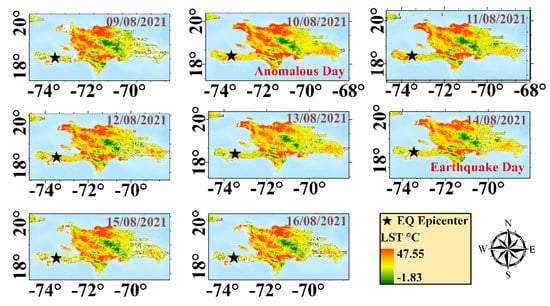
Figure 2.
Spatial maps of MODIS LST before and after the 2021 Haiti EQ, where the black star is for the EQ epicenter.
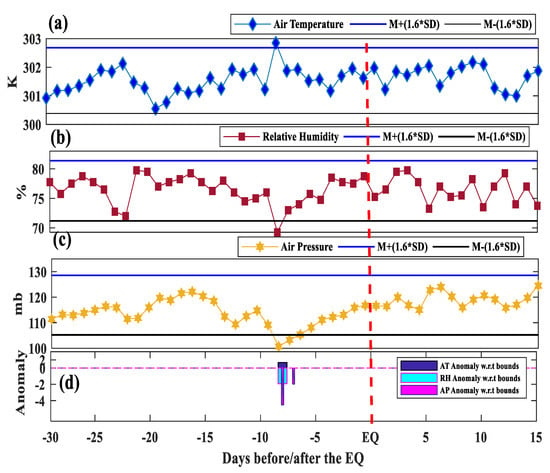
Figure 3.
(a) AT time series, (b) RH time series, (c) temporal variation of AP over the epicentral zone with the upper and lower bounds of mean and standard deviation, and (d) the deviation of AT, RH, and AP from the upper and lower bounds of mean and standard deviation. The red dashed line indicates the EQ day.
An increase in AT of about 1.62 K from the upper bound occurred on 5 August 2021 (Figure 3d). Similarly, a sharp decrease of 4.5 millibar also occurred in AP on 5 August 2021 and 6 August 2021 (9 and 8 days before the EQ). At the epicenter of the EQ, a significant thermal anomaly was observed on 10 August 2021 (Figure 4a). The temporal dataset of MODIS LST values recorded a 2.92°C rise in temperature within 4 days before the EQ (Figure 4d). All these atmospheric parameters showed anomalies within a 10-day window before the main shock, which strongly support the lithosphere–atmosphere coupling phenomenon. Additionally, EQ-induced ionization occurs at various altitude levels in the atmosphere, and we observed it in OLR variations (Figure 4a). A sharp increase of 4.71 W/m2 occurred in OLR values on 11 August 2021 (3 days before the EQ) over the epicenter of the Mw 7.2 Haiti.
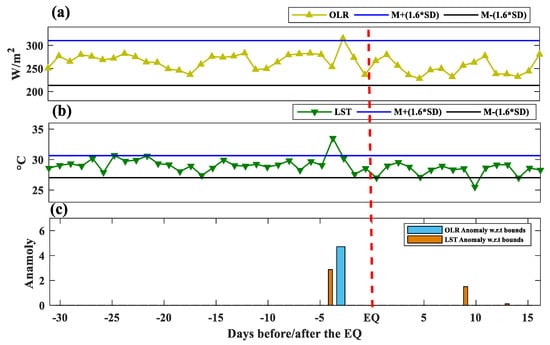
Figure 4.
(a) Time-series of OLR, (b) LST over the epicentral region with bounds, (c) the deviation of OLR and LST values from the upper and lower bounds. The red line indicates the EQ day.
A continuous wavelet transformation has been employed on RH, AT, AP, LST, and OLR time series to provide more evidence for the existence of abnormal atmospheric anomalies (Figure 5). The wavelet analyses depict an apparent anomaly within a 10-day window prior to the EQ. A sharp enhancement in atmospheric parameters occurred within 5–10 days before the Haiti event, and thus, they agree with the time series analyses within the EQ preparation period.

Figure 5.
Time series of (a) LST, (b) OLR, (c) AT, (d) RH, and (e) AP in the form of wavelet transformation for the detection of anomalies associated with the Haiti EQ.
We also implemented the NARX method on all the atmospheric parameters. The relative humidity (RH) observed in time series on August 5, 2021 was around 69.2%, and the humidity predicted by NARX was 75.2% (Figure 6b). Due to this, negative deviation of approximately 6.02% was detected 9 days before the impending EQ (Figure 6d). In the air temperature (AT) time series, a positive deviation of 0.95 K was recorded 9 days before the main shock on 5 August 2021 (Figure 6c). AP also exhibited a negative deviation of 12.19 mb on 5 August 2021. Furthermore, a deviation of 3.64°C between measured LST and NARX predicted was observed just 4 days before the EQ (Figure 7c). The OLR exhibited the anomalous enhancement of >70 W/m2 three days before EQ and depicted the difference of 58.38 W/m2 from NARX predicted values within the 10-day window (Figure 7a–c). The anomalous deviation in Figure 7d is clearly visible 5–10 days before the main shock. This confirms that statistical and machine learning methods agree regarding EQ-induced atmospheric anomalies.
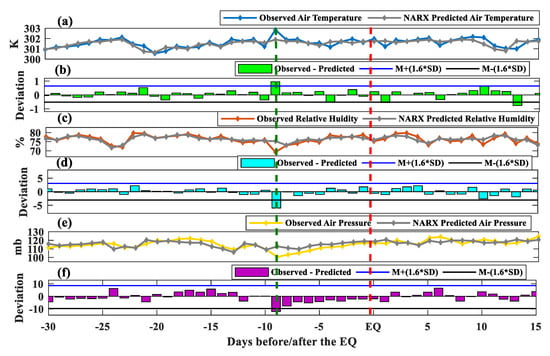
Figure 6.
Comparison between the observed and NARX-predicted for (a) AT, (b) deviation of AT, (c) RH, (d) deviation of RH, (e) AP, and (f) deviation of AP. The green line indicates the anomalous day and the red line indicates the day of EQ.
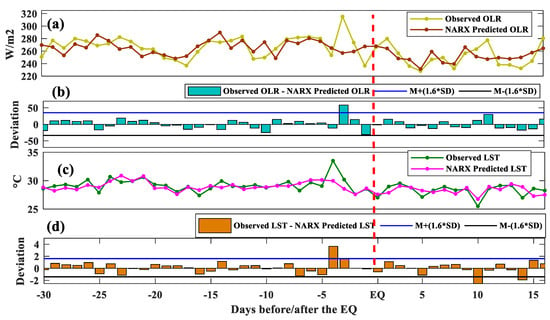
Figure 7.
Comparison between the observed and NARX-predicted (a) OLR, (b) deviation of OLR, (c) LST, and (d) deviation of LST. The red line is for the day of EQ.
A positive deviation was recorded in the predicted values by the LSTM algorithm, as compared to the original AT, by an amount of 1.63 K 9 days before the main shock (Figure 8a,b). In the RH time series, a maximum negative deviation of 9.08% was recorded on 4 August, corresponding to 8 days before the main shock (Figure 8c,d). In the AP time series, we detected negative deviations on the 4th, 5th, and 6th of August, but the highest value was 27.48 mb on 5 August, the 9th day before the main shock (Figure 8e,f). The analysis of LSTM completely matched with the original time series. The OLR and LST data series in LSTM have significant variations of >50 W/m2 and 3.79°C, respectively (Figure 9b,d). Both of the parameters showed positive deviations in the predicted and observed values between LST and OLR on 10 August 2021, which corresponds to four days before the EQ event (Figure 9). All these anomalies fell within the window of 5–10 days before the main shock. A maximum positive variance of 72.23 W/m2 was detected on 11 August 2021, as evident in Figure 9d.

Figure 8.
Comparison between the observed and LSTM-predicted (a) AT, (b) deviations in AT, (c) RH, (d) deviation in RH, (e) AP and (f) deviation in AP with the upper and lower bounds. The green line indicates the anomalous behavior days, and the red line is for the day of EQ.
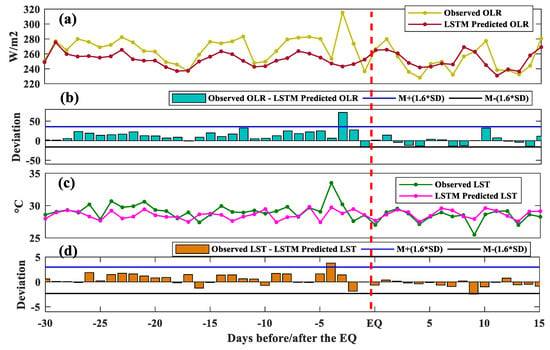
Figure 9.
Comparison between observed and LSTM-predicted (a) OLR, (b) deviation in OLR, (c) LST and (d) deviation in LST. The red line shows the day of EQ.
Therefore, the anomalies were detected by evaluating the variation outside the confidence ranges within a 10-day window of the atmospheric parameters prior to the EQ. The correlation analysis of original and predicted values for both the NARX and LSTM algorithms is shown in Figure 10.
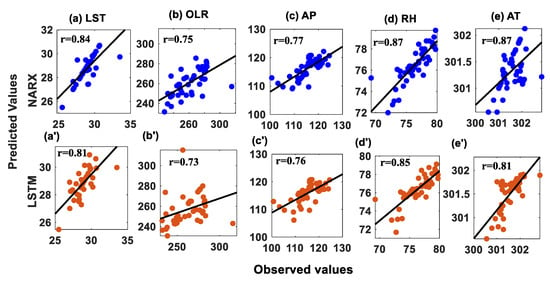
Figure 10.
Correlation graph between the observed and predicted values in NARX for (a) LST, (b) OLR, (c) AP, (d) RH, and (e) AT and LSTM time series for (a’) LST, (b’) OLR, (c’) AP, (d’) RH, and (e’) AT.
The correlation of NARX and LSTM algorithms depicts excellent correlation between both the observed and predicted values. The OLR and AP show less correlation than other atmospheric constituents. However, the overall correlation is of a moderate scale. Moreover, the observed LST exhibited correlation of 0.84 and 0.81 with predicted vales of NARX and LSTM, respectively. Furthermore, NARX-predicted values showed correlations of 0.75, 0.77, and 0.87 with observed OLR, AP, and RH, respectively. On the other hand, observed LST, OLR, and AP depicted correlations of 0.73, 0.76, and 0.87 with LSTM predicted values, respectively. Moreover, only observed AT exhibited a stronger correlation with LSTM values than NARX predicted values (i.e., 0.81 with LSTM and 0.79 for NARX). Table 1 summarizes the atmospheric anomalies within the time window of 5–10 days, as well as the outcome from the techniques employed in this study. Furthermore, Taylor diagrams offer a simple visualization of strong correlation for multiple parameters [32]. The good to moderate correlation offer good insights for EQ-induced atmospheric anomalies (Figure 11). All these analyses have confirmed the existence of EQ-induced atmospheric anomalies by information from multiple satellites.

Table 1.
Illustration of atmospheric anomalies using different techniques.
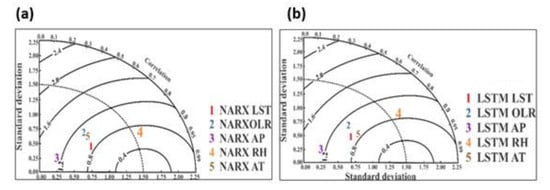
Figure 11.
(a) Observed and predicted modes correlation for NARX, (b) Taylor diagram of the observed and predicted modes correlation for LSTM.
4.2. Possible Mechanism
The results of all these analyses reveal significant atmospheric variations caused by the EQ in Haiti. More evidence and insights from satellite-based EQ forecasting were provided by several articles on EQ precursors [1,3,16,33,34]. Similarly, the results of this study on the atmospheric anomalies associated with the Haiti EQ are in agreement with previous findings [6,30,35]. However, further research may also be undertaken in other regions in order to clarify and endorse the lithosphere–atmosphere coupling mechanism and to study the occurrence of future atmospheric anomalies before and after EQs.
In order to gain a comprehensive understanding of the seismic anomalies, it is crucial to understand the simultaneous processes and geology surrounding the EQ preparation zone. Several researchers have reported that radon emissions from rocks could be induced by seismic activity due to stress along fault lines [36,37]. Moreover, experimental evidence supports the enhanced Radon emanations from macro fault lines during seismic activity [38]. According to the mechanism offered by Pulinets et al. [31], several chemical and physical processes occur in the atmosphere as a consequence of the radiation emitted by radon gas decay. When this charged carrier is within a finite volume of the rock, the rock emits higher levels of infrared radiation, thereby increasing the LST over the seismic surrounding area [6,8,39,40,41]. As a result of the ionization and chemical reaction, large clusters of ions are formed. Consequently, water vapor condenses, and enhancement in latent heat exhalation takes place. Moreover, increasing radon discharges cause changes in air temperature and relative humidity over EQ active areas due to seismically induced chemical compositions [31,42].
Additionally, a study conducted by Planinic et al. [43] in 1999 and 2000 before EQs found an inverse correlation between air pressure and radon levels. According to previous reports, increasing radon concentrations contributed to a significant reduction in air pressure before an impending EQ [44,45,46]. As a result of these atmospheric fluctuations, additional heat fluxes are generated from latent heat, called outgoing long wave radiations, in the Earth’s atmosphere [47,48,49,50]. These processes can evolve to atmosphere by different pathways [51,52,53,54,55]. Furthermore, decay of Radon discharging are the key sources of air ionization that contribute to aerosol-size ions. An atmospheric electric field alteration can be observed in the manifestation of induced aerosol fluxes [45]. Nevertheless, enhanced radon emanation across the fault lines has been empirically demonstrated in other case studies by Tuccimei et al. [38]. Our research has also examined atmospheric factors by different methods like previous reports [56,57,58,59,60]. In addition, we highlighted different methods for our anomalies similar to previous reports [61,62,63,64,65]. There are many different satellites for observation of different natural hazards on the Earth [66,67,68,69,70]. There is a need to utilize more data to directly link the radon emanation hypothesis for EQ forecasting [71,72,73,74,75]. There is also a need to enhance the satellite clusters for EQ monitoring to discover a solution for main shock forecasting [76,77,78]. There are many reports of EQ anomalies from different satellites [79,80,81,82,83,84], but this study provides a deep analysis of the seismic precursors.
5. Conclusions
The integrated analyses of multiple atmospheric parameters are studied by statistical, wavelet, and ML methods for the purpose of detecting irregularities in the atmosphere associated with the Haiti EQ for a possible precursory phenomenon. The main findings are below.
- (1)
- The LST, AT, RH, AP, and OLR show an unusual variation beyond the defined bounds in the statistical analysis during the 10-day window prior to the seismic event.
- (2)
- The anomalous behavior of all the atmospheric parameters is confirmed in wavelet transformations by the local maxima approximation from the time series data within 5–10 days before the EQ.
- (3)
- While using NARX and LSTM algorithms, the maximum of AT, RH, and AP deviation between the observed and predicted values was 5–10 days before the main shock. Nevertheless, for LST and OLR, anomalies occurred within the 5 days before the EQ main shock.
By analyzing multi-parameter data with statistical, ML, wavelet, and spatial analysis, we were able to conclude the precursory nature of these atmospheric parameters related to the EQ. In addition, multiple types of analyses allowed us to confirm the LAIC phenomenon within the 5–10 day window around the EQ main shock. However, more analyses are needed to accurately predict the EQ using more parameters, better techniques, and best data resolution.
Author Contributions
Conceptualization, M.S.; methodology; software, M.M.K. and R.S.; validation, B.G. and N.A.N.; writing—review and editing, M.R.K., A.H.A., S.M.E., R.A. All authors have read and agreed to the published version of the manuscript.
Funding
This study is supported by the Deanship of Scientific Research at Umm Al-Qura University by Grant Code: 22UQU4331100DSR21.
Institutional Review Board Statement
Not applicable.
Informed Consent Statement
Not applicable.
Data Availability Statement
Not applicable.
Acknowledgments
The authors would like to thank the Deanship of Scientific Research at Umm Al-Qura University for supporting this work by Grant Code: (22UQU4331100DSR21). Authors are appreciative to Earth explorer (NASA) for MODIS data. We are indebted to the NOAA-PSL community for providing the atmospheric datasets, and we are also thankful to USGS for providing earthquake data and information about tectonic plate motion.
Conflicts of Interest
The authors declare no conflict of interest.
References
- Liu, J.Y.; Chuo, Y.J.; Shan, S.J.; Tsai, Y.B.; Chen, Y.I.; Pulinets, S.; Yu, S.B. Pre-earthquake ionospheric anomalies registered by continuous GPS TEC measurements. Ann. Geophys. 2004, 22, 1585–1593. [Google Scholar] [CrossRef]
- Pulinets, S.; Dunajecka, M. Specific variations of air temperature and relative humidity around the time of Michoacan earthquake M8.1 Sept. 19, 1985 as a possible indicator of interaction between tectonic plates. Tectonophysics 2007, 431, 221–230. [Google Scholar] [CrossRef]
- Kuo, C.L.; Lee, L.C.; Huba, J.D. An improved coupling model for the lithosphere-atmosphere-ionosphere system. J. Geophys. Res. Space Phys. 2014, 119, 3189–3205. [Google Scholar] [CrossRef]
- Daneshvar, M.R.M.; Freund, F.T. Remote Sensing of Atmospheric and Ionospheric Signals Prior to the Mw 8.3 Illapel Earthquake, Chile 2015. Pure Appl. Geophys. 2016, 174, 11–45. [Google Scholar] [CrossRef]
- Freeshah, M.; Zhang, X.; Şentürk, E.; Adil, M.A.; Mousa, B.G.; Tariq, A.; Ren, X.; Refaat, M. Analysis of Atmospheric and Ionospheric Variations Due to Impacts of Super Typhoon Mangkhut (1822) in the Northwest Pacific Ocean. Remote Sens. 2021, 13, 661. [Google Scholar] [CrossRef]
- Hafeez, A.; Ehsan, M.; Abbas, A.; Shah, M.; Shahzad, R. Machine learning-based thermal anomalies detection from MODIS LST associated with the Mw 7.7 Awaran, Pakistan earthquake. Nat. Hazards 2022, 111, 2097–2115. [Google Scholar] [CrossRef]
- Hafeez, A.; Shah, M.; Ehsan, M.; Jamjareegulgarn, P.; Ahmed, J.; Tariq, M.A.; Iqbal, S.; Naqvi, N.A. Possible Atmosphere and Ionospheric Anomalies of the 2019 Pakistan Earthquake Using Statistical and Machine Learning Procedures on MODIS LST, GPS TEC, and GIM TEC. IEEE J. Sel. Top. Appl. Earth Obs. Remote Sens. 2021, 14, 11126–11133. [Google Scholar] [CrossRef]
- Xu, X.; Chen, S.; Yu, Y.; Zhang, S. Atmospheric Anomaly Analysis Related to Ms > 6.0 Earthquakes in China during 2020–2021. Remote Sens. 2021, 13, 4052. [Google Scholar] [CrossRef]
- Shah, M.; Jin, S. Pre-seismic ionospheric anomalies of the 2013 Mw = 7.7 Pakistan earthquake from GPS and COSMIC observations. Geodesy Geodyn. 2018, 9, 378–387. [Google Scholar] [CrossRef]
- Wei, L.; Li, J.; Liu, L.; Huang, L.; Zheng, D.; Tian, X.; Huang, L.; Zhou, L.; Ren, C.; He, H. Lithosphere Ionosphere Coupling Associated with Seismic Swarm in the Balkan Peninsula from ROB-TEC and GPS. Remote Sens. 2022, 14, 4759. [Google Scholar] [CrossRef]
- Geller, R.J. Earthquake prediction: A critical review. Geophys. J. Int. 1997, 131, 425–450. [Google Scholar] [CrossRef]
- Pulinets, S.; Ouzounov, D. Lithosphere–Atmosphere–Ionosphere Coupling (LAIC) model—An unified concept for earthquake precursors validation. J. Southeast Asian Earth Sci. 2011, 41, 371–382. [Google Scholar] [CrossRef]
- Kojima, H.; Yoshino, C.; Nemoto, K.; Hattori, K.; Konishi, T.; Furuya, R. Multi-channel singular spectrum analysis of underground Rn concentration at Asahi station, Boso Peninsula, Japan: Preliminary report on relation between the variation of underground Rn flux and the local seismic activity. J. Atmospheric Electr. 2020, 39, 46–51. [Google Scholar] [CrossRef]
- Deb, A.; Gazi, M.; Barman, C. Anomalous soil radon fluctuations—Signal of earthquakes in Nepal and eastern India regions. J. Earth Syst. Sci. 2016, 125, 1657–1665. [Google Scholar] [CrossRef]
- D’Alessandro, A.; Scudero, S.; Siino, M.; Alessandro, G.; Mineo, R. Long-Term Monitoring and Characterization of Soil Radon Emission in a Seismically Active Area. Geochem. Geophys. Geosystems 2020, 21, e2020GC009061. [Google Scholar] [CrossRef]
- Salikhov, N.; Shepetov, A.; Pak, G.; Nurakynov, S.; Ryabov, V.; Saduyev, N.; Sadykov, T.; Zhantayev, Z.; Zhukov, V. Monitoring of Gamma Radiation Prior to Earthquakes in a Study of Lithosphere-Atmosphere-Ionosphere Coupling in Northern Tien Shan. Atmosphere 2022, 13, 1667. [Google Scholar] [CrossRef]
- Adil, M.A.; Şentürk, E.; Pulinets, S.A.; Amory-Mazaudier, C. A Lithosphere–Atmosphere–Ionosphere Coupling Phenomenon Observed Before M 7.7 Jamaica Earthquake. Pure Appl. Geophys. 2021, 178, 3869–3886. [Google Scholar] [CrossRef]
- Freund, F.; Ouillon, G.; Scoville, J.; Sornette, D. Earthquake precursors in the light of peroxy defects theory: Critical review of systematic observations. Eur. Phys. J. Speéc. Top. 2021, 230, 7–46. [Google Scholar] [CrossRef]
- Jiao, Z.; Shan, X. Pre-Seismic Temporal Integrated Anomalies from Multiparametric Remote Sensing Data. Remote Sens. 2022, 14, 2343. [Google Scholar] [CrossRef]
- Dobrovolsky, I.P.; Zubkov, S.I.; Miachkin, V.I. Estimation of the size of earthquake preparation zones. Pure Appl. Geophys. 1979, 117, 1025–1044. [Google Scholar] [CrossRef]
- U.S. Geological Survey, 2020, Earthquake Lists, Maps, and Statistics. Available online: https://www.usgs.gov/natural-hazards/earthquake-hazards/lists-maps-and-statistics (accessed on 18 June 2022).
- Ouzounov, D.; Freund, F. Mid-infrared emission prior to strong earthquakes analyzed by remote sensing data. Adv. Space Res. 2004, 33, 268–273. [Google Scholar] [CrossRef]
- Chen, S.; Liu, P.; Feng, T.; Wang, D.; Jiao, Z.; Chen, L.; Xu, Z.; Zhang, G. Exploring Changes in Land Surface Temperature Possibly Associated with Earthquake: Case of the April 2015 Nepal Mw 7.9 Earthquake. Entropy 2020, 22, 377. [Google Scholar] [CrossRef]
- Monteiro, L.d.S.; de Oliveira-Júnior, J.F.; Ghaffar, B.; Tariq, A.; Qin, S.; Mumtaz, F.; Filho, W.L.F.C.; Shah, M.; Jardim, A.M.D.R.F.; da Silva, M.V.; et al. Rainfall in the Urban Area and Its Impact on Climatology and Population Growth. Atmosphere 2022, 13, 1610. [Google Scholar] [CrossRef]
- Daily Climate Composites: NOAA Physical Sciences Laboratory, Boulder, Colorado, USA. Available online: https://psl.noaa.gov/data/composites/day/ (accessed on 18 October 2022).
- Shah, M.; Abbas, A.; Adil, M.A.; Ashraf, U.; de Oliveira-Júnior, J.F.; Tariq, M.A.; Ahmed, J.; Ehsan, M.; Ali, A. Possible seismo-ionospheric anomalies associated with M > 5.0 earthquakes during 2000–2020 from GNSS TEC. Adv. Space Res. 2022, 70, 179–187. [Google Scholar] [CrossRef]
- de Oliveira-Júnior, J.F.; Shah, M.; Abbas, A.; Filho, W.L.F.C.; Junior, C.A.D.S.; Santiago, D.D.B.; Teodoro, P.E.; Mendes, D.; de Souza, A.; Aviv-Sharon, E.; et al. Spatiotemporal Analysis of Fire Foci and Environmental Degradation in the Biomes of Northeastern Brazil. Sustainability 2022, 14, 6935. [Google Scholar] [CrossRef]
- Tariq, M.A.; Shah, M.; Li, Z.; Wang, N.; Iqbal, T.; Liu, L. Lithosphere ionosphere coupling associated with three earthquakes in Pakistan from GPS and GIM TEC. J. Geodyn. 2021, 147, 101860. [Google Scholar] [CrossRef]
- Mehdi, S.; Shah, M.; Naqvi, N.A. Lithosphere atmosphere ionosphere coupling associated with the 2019 Mw 7.1 California earthquake using GNSS and multiple satellites. Environ. Monit. Assess. 2021, 193, 501. [Google Scholar] [CrossRef]
- Adil, M.A.; Abbas, A.; Ehsan, M.; Shah, M.; Naqvi, N.A.; Alie, A. Investigation of ionospheric and atmospheric anomalies associated with three Mw > 6.5 EQs in New Zealand. J. Geodyn. 2021, 145, 101841. [Google Scholar] [CrossRef]
- Pulinets, S.A.; Ouzounov, D.; Karelin, A.V.; Davidenko, D. Physical bases of the generation of short-term earthquake precursors: A complex model of ionization-induced geophysical processes in the lithosphere-atmosphere-ionosphere-magnetosphere system. Geomagn. Aeron. 2015, 55, 521–538. [Google Scholar] [CrossRef]
- Shahzad, R.; Shah, M.; Ahmed, A. Comparison of VTEC from GPS and IRI-2007, IRI-2012 and IRI-2016 over Sukkur Pakistan. Astrophys. Space Sci. 2021, 366, 42. [Google Scholar] [CrossRef]
- Shah, M.; Aibar, A.C.; Tariq, M.A.; Ahmed, J.; Ahmed, A. Possible ionosphere and atmosphere precursory analysis related to Mw > 6.0 earthquakes in Japan. Remote Sens. Environ. 2019, 239, 111620. [Google Scholar] [CrossRef]
- Adil, M.A.; Şentürk, E.; Shah, M.; Naqvi, N.A.; Saqib, M.; Abbasi, A.R. Atmospheric and ionospheric disturbances associated with the M > 6 earthquakes in the East Asian sector: A case study of two consecutive earthquakes in Taiwan. J. Southeast Asian Earth Sci. 2021, 220, 104918. [Google Scholar] [CrossRef]
- Shah, M.; Qureshi, R.U.; Khan, N.G.; Ehsan, M.; Yan, J. Artificial Neural Network based thermal anomalies associated with earthquakes in Pakistan from MODIS LST. J. Atmospheric Solar-Terrestrial Phys. 2021, 215, 105568. [Google Scholar] [CrossRef]
- Shah, M.; Ahmed, A.; Ehsan, M.; Khan, M.; Tariq, M.A.; Calabia, A.; Rahman, Z.U. Total electron content anomalies associated with earthquakes occurred during 1998–2019. Acta Astronaut. 2020, 175, 268–276. [Google Scholar] [CrossRef]
- Shah, M.; Inyurt, S.; Ehsan, M.; Ahmed, A.; Shakir, M.; Ullah, S.; Iqbal, M.S. Seismo ionospheric anomalies in Turkey associated with M ≥ 6.0 earthquakes detected by GPS stations and GIM TEC. Adv. Space Res. 2020, 65, 2540–2550. [Google Scholar] [CrossRef]
- Kiyani, A.; Shah, M.; Ahmed, A.; Shah, H.H.; Hameed, S.; Adil, M.A.; Naqvi, N.A. Seismo ionospheric anomalies possibly associated with the 2018 M 8.2 Fiji earthquake detected with GNSS TEC. J. Geodyn. 2020, 140, 101782. [Google Scholar] [CrossRef]
- Pulinets, S.A.; Ouzounov, D.; Ciraolo, L.; Singh, R.; Cervone, G.; Leyva, A.; Dunajecka, M.; Karelin, A.V.; Boyarchuk, K.A.; Kotsarenko, A. Thermal, atmospheric and ionospheric anomalies around the time of the Colima M7.8 earthquake of 21 January 2003. Ann. Geophys. 2006, 24, 835–849. [Google Scholar] [CrossRef]
- Pavlidou, E.; van der Meijde, M.; van der Werff, H.; Hecker, C. Time Series Analysis of Land Surface Temperatures in 20 Earthquake Cases Worldwide. Remote Sens. 2018, 11, 61. [Google Scholar] [CrossRef]
- Liu, J.; Hagan, D.F.T.; Holmes, T.R.; Liu, Y. An Analysis of Spatio-Temporal Relationship between Satellite-Based Land Surface Temperature and Station-Based Near-Surface Air Temperature over Brazil. Remote Sens. 2022, 14, 4420. [Google Scholar] [CrossRef]
- Abbasi, A.R.; Shah, M.; Ahmed, A.; Naqvi, N.A. Possible ionospheric anomalies associated with the 2009 Mw 6.4 Taiwan earthquake from DEMETER and GNSS TEC. Acta Geod. et Geophys. 2020, 56, 77–91. [Google Scholar] [CrossRef]
- Shah, M.; Tariq, M.A.; Naqvi, N.A. Atmospheric anomalies associated with Mw>6.0 earthquakes in Pakistan and Iran during 2010–2017. J. Atmos. Solar-Terr. Phys. 2019, 191, 105056. [Google Scholar] [CrossRef]
- Ouzounov, D.; Liu, D.; Chunli, K.; Cervone, G.; Kafatos, M.; Taylor, P. Outgoing long wave radiation variability from IR satellite data prior to major earthquakes. Tectonophysics 2007, 431, 211–220. [Google Scholar] [CrossRef]
- Boyarchuk, K.; Lomonosov, A.; Pulinets, S.A.; Hegai, V.V. Variability of the Earth’s Atmospheric Electric Field and Ion-Aerosols Kinetics in the Troposphere. Stud. Geophys. et Geod. 1998, 42, 197–210. [Google Scholar] [CrossRef]
- Zhang, Z.; Luo, C.; Zhao, Z. Application of probabilistic method in maximum tsunami height prediction considering stochastic seabed topography. Nat. Hazards 2020, 104, 2511–2530. [Google Scholar] [CrossRef]
- Alam, Z.; Sun, L.; Zhang, C.; Samali, B. Influence of seismic orientation on the statistical distribution of nonlinear seismic response of the stiffness-eccentric structure. Structures 2022, 39, 387–404. [Google Scholar] [CrossRef]
- Xu, J.; Zhou, L.; Li, Y.; Ding, J.; Wang, S.; Cheng, W.-C. Experimental Study on Uniaxial Compression Behavior of Fissured Loess Before and After Vibration. Int. J. Geomech. 2022, 22, 04021277. [Google Scholar] [CrossRef]
- Yue, Z.; Zhou, W.; Li, T. Impact of the Indian Ocean Dipole on Evolution of the Subsequent ENSO: Relative Roles of Dynamic and Thermodynamic Processes. J. Clim. 2021, 34, 3591–3607. [Google Scholar] [CrossRef]
- Zhang, K.; Ali, A.; Antonarakis, A.; Moghaddam, M.; Saatchi, S.; Tabatabaeenejad, A.; Chen, R.; Jaruwatanadilok, S.; Cuenca, R.; Crow, W.T.; et al. The Sensitivity of North American Terrestrial Carbon Fluxes to Spatial and Temporal Variation in Soil Moisture: An Analysis Using Radar-Derived Estimates of Root-Zone Soil Moisture. J. Geophys. Res. Biogeosciences 2019, 124, 3208–3231. [Google Scholar] [CrossRef]
- Wang, S.; Zhang, K.; Chao, L.; Li, D.; Tian, X.; Bao, H.; Chen, G.; Xia, Y. Exploring the utility of radar and satellite-sensed precipitation and their dynamic bias correction for integrated prediction of flood and landslide hazards. J. Hydrol. 2021, 603, 126964. [Google Scholar] [CrossRef]
- Mao, Y.; Sun, R.; Wang, J.; Cheng, Q.; Kiong, L.C.; Ochieng, W.Y. New time-differenced carrier phase approach to GNSS/INS integration. GPS Solut. 2022, 26, 122. [Google Scholar] [CrossRef]
- Li, Z.-J.; Zhang, K. Comparison of Three GIS-Based Hydrological Models. J. Hydrol. Eng. 2008, 13, 364–370. [Google Scholar] [CrossRef]
- Xie, W.; Li, X.; Jian, W.; Yang, Y.; Liu, H.; Robledo, L.; Nie, W. A Novel Hybrid Method for Landslide Susceptibility Mapping-Based GeoDetector and Machine Learning Cluster: A Case of Xiaojin County, China. ISPRS Int. J. Geo-Inf. 2021, 10, 93. [Google Scholar] [CrossRef]
- Xie, W.; Nie, W.; Saffari, P.; Robledo, L.F.; Descote, P.-Y.; Jian, W. Landslide hazard assessment based on Bayesian optimization–support vector machine in Nanping City, China. Nat. Hazards 2021, 109, 931–948. [Google Scholar] [CrossRef]
- Wang, G.; Zhao, B.; Wu, B.; Wang, M.; Liu, W.; Zhou, H.; Zhang, C.; Wang, Y.; Han, Y. Research on the Macro-Mesoscopic Response Mechanism of Multisphere Approximated Heteromorphic Tailing Particles. Lithosphere 2022, 2022, 1977890. [Google Scholar] [CrossRef]
- Wang, G.; Zhao, B.; Wu, B.; Zhang, C.; Liu, W. Intelligent prediction of slope stability based on visual exploratory data analysis of 77 in situ cases. Int. J. Min. Sci. Technol. 2022. [Google Scholar] [CrossRef]
- Zhu, Z.; Wu, Y.; Liang, Z. Mining-Induced Stress and Ground Pressure Behavior Characteristics in Mining a Thick Coal Seam With Hard Roofs. Front. Earth Sci. 2022, 10, 843191. [Google Scholar] [CrossRef]
- Wu, X.; Liu, Z.; Yin, L.; Zheng, W.; Song, L.; Tian, J.; Yang, B.; Liu, S. A Haze Prediction Model in Chengdu Based on LSTM. Atmosphere 2021, 12, 1479. [Google Scholar] [CrossRef]
- Yin, L.; Wang, L.; Huang, W.; Liu, S.; Yang, B.; Zheng, W. Spatiotemporal Analysis of Haze in Beijing Based on the Multi-Convolution Model. Atmosphere 2021, 12, 1408. [Google Scholar] [CrossRef]
- Yin, L.; Wang, L.; Zheng, W.; Ge, L.; Tian, J.; Liu, Y.; Yang, B.; Liu, S. Evaluation of Empirical Atmospheric Models Using Swarm-C Satellite Data. Atmosphere 2022, 13, 294. [Google Scholar] [CrossRef]
- Zhang, X.; Ma, F.; Yin, S.; Wallace, C.D.; Soltanian, M.R.; Dai, Z.; Ritzi, R.W.; Ma, Z.; Zhan, C.; Lü, X. Application of upscaling methods for fluid flow and mass transport in multi-scale heterogeneous media: A critical review. Appl. Energy 2021, 303, 117603. [Google Scholar] [CrossRef]
- Huang, S.; Liu, C. A computational framework for fluid–structure interaction with applications on stability evaluation of breakwater under combined tsunami–earthquake activity. Comput. Civ. Infrastruct. Eng. 2022, 1–28. [Google Scholar] [CrossRef]
- Li, J.; Cheng, F.; Lin, G.; Wu, C. Improved Hybrid Method for the Generation of Ground Motions Compatible with the Multi-Damping Design Spectra. J. Earthq. Eng. 2022, 2, 20–26. [Google Scholar] [CrossRef]
- Huang, S.; Lyu, Y.; Sha, H.; Xiu, L. Seismic performance assessment of unsaturated soil slope in different groundwater levels. Landslides 2021, 18, 2813–2833. [Google Scholar] [CrossRef]
- Tian, H.; Qin, Y.; Niu, Z.; Wang, L.; Ge, S. Summer Maize Mapping by Compositing Time Series Sentinel-1A Imagery Based on Crop Growth Cycles. J. Indian Soc. Remote Sens. 2021, 49, 2863–2874. [Google Scholar] [CrossRef]
- Tian, H.; Wang, Y.; Chen, T.; Zhang, L.; Qin, Y. Early-Season Mapping of Winter Crops Using Sentinel-2 Optical Imagery. Remote Sens. 2021, 13, 3822. [Google Scholar] [CrossRef]
- Chen, L.; Huang, Y.; Yu, X.; Lu, J.; Jia, W.; Song, J.; Liu, L.; Wang, Y.; Huang, Y.; Xie, J.; et al. Corynoxine Protects Dopaminergic Neurons Through Inducing Autophagy and Diminishing Neuroinflammation in Rotenone-Induced Animal Models of Parkinson’s Disease. Front. Pharmacol. 2021, 12, 642900. [Google Scholar] [CrossRef] [PubMed]
- Zhao, M.; Zhou, Y.; Li, X.; Cheng, W.; Zhou, C.; Ma, T.; Li, M.; Huang, K. Mapping urban dynamics (1992–2018) in Southeast Asia using consistent nighttime light data from DMSP and VIIRS. Remote Sens. Environ. 2020, 248, 111980. [Google Scholar] [CrossRef]
- Zhao, M.; Zhou, Y.; Li, X.; Zhou, C.; Cheng, W.; Li, M.; Huang, K. Building a Series of Consistent Night-Time Light Data (1992–2018) in Southeast Asia by Integrating DMSP-OLS and NPP-VIIRS. IEEE Trans. Geosci. Remote Sens. 2019, 58, 1843–1856. [Google Scholar] [CrossRef]
- Qu, J.; Feng, Y.; Xu, G.; Zhang, M.; Zhu, Y.; Zhou, S. Design and thermodynamics analysis of marine dual fuel low speed engine with methane reforming integrated high pressure exhaust gas recirculation system. Fuel 2022, 319, 123747. [Google Scholar] [CrossRef]
- Yang, J.; Fu, L.-Y.; Zhang, Y.; Han, T. Temperature- and Pressure-Dependent Pore Microstructures Using Static and Dynamic Moduli and Their Correlation. Rock Mech. Rock Eng. 2022, 55, 4073–4092. [Google Scholar] [CrossRef]
- Cheng, Y.; Fu, L.-Y. Nonlinear seismic inversion by physics-informed Caianiello convolutional neural networks for overpressure prediction of source rocks in the offshore Xihu depression, East China. J. Pet. Sci. Eng. 2022, 215, 110654. [Google Scholar] [CrossRef]
- Zhao, F.; Song, L.; Peng, Z.; Yang, J.; Luan, G.; Chu, C.; Ding, J.; Feng, S.; Jing, Y.; Xie, Z. Night-Time Light Remote Sensing Mapping: Construction and Analysis of Ethnic Minority Development Index. Remote Sens. 2021, 13, 2129. [Google Scholar] [CrossRef]
- Zhao, F.; Zhang, S.; Du, Q.; Ding, J.; Luan, G.; Xie, Z. Assessment of the sustainable development of rural minority settlements based on multidimensional data and geographical detector method: A case study in Dehong, China. Socio-Economic Plan. Sci. 2021, 78, 101066. [Google Scholar] [CrossRef]
- Shah, M.; Ehsan, M.; Abbas, A.; Ahmed, A.; Jamjareegulgarn, P. Possible Thermal Anomalies Associated With Global Terrestrial Earthquakes During 2000–2019 Based on MODIS-LST. IEEE Geosci. Remote Sens. Lett. 2021, 19, 1–5. [Google Scholar] [CrossRef]
- Shah, M.; Abbas, A.; Ehsan, M.; Calabia, A.; Adhikari, B.; Tariq, M.A.; Ahmed, J.; de Oliveira-Junior, J.F.; Yan, J.; Melgarejo-Morales, A.; et al. Ionospheric–Thermospheric Responses in South America to the August 2018 Geomagnetic Storm Based on Multiple Observations. IEEE J. Sel. Top. Appl. Earth Obs. Remote Sens. 2021, 15, 261–269. [Google Scholar] [CrossRef]
- Shah, M.; Tariq, M.A.; Ahmad, J.; Naqvi, N.A.; Jin, S. Seismo ionospheric anomalies before the 2007 M7.7 Chile earthquake from GPS TEC and DEMETER. J. Geodyn. 2019, 127, 42–51. [Google Scholar] [CrossRef]
- Shah, M.; Jin, S. Statistical characteristics of seismo-ionospheric GPS TEC disturbances prior to global Mw≥5.0 earthquakes (1998–2014). J. Geodyn. 2015, 92, 42–49. [Google Scholar] [CrossRef]
- Tariq, M.A.; Shah, M.; Hernández-Pajares, M.; Iqbal, T. Pre-earthquake ionospheric anomalies before three major earthquakes by GPS-TEC and GIM-TEC data during 2015–2017. Adv. Space Res. 2019, 63, 2088–2099. [Google Scholar] [CrossRef]
- Ahmed, J.; Shah, M.; Zafar, W.A.; Amin, M.A.; Iqbal, T. Seismoionospheric anomalies associated with earthquakes from the analysis of the ionosonde data. J. Atmos. Sol.-Terr. Phys. 2018, 179, 450–458. [Google Scholar] [CrossRef]
- Liu, X.; Zhang, Q.; Shah, M.; Hong, Z. Atmospheric-ionospheric disturbances following the April 2015 Calbuco volcano from GPS and OMI observations. Adv. Space Res. 2017, 60, 2836–2846. [Google Scholar] [CrossRef]
- Shah, M.; Khan, M.; Ullah, H.; Ali, S. Thermal Anomalies Prior to The 2015 Gorkha (Nepal) Earthquake From Modis Land Surface Temperature and Outgoing Longwave Radiations. Geodyn. Tectonophys. 2018, 9, 123–138. [Google Scholar] [CrossRef]
- Hussain, A.; Shah, M. Comparison of GPS TEC with IRI models of 2007, 2012, & 2016 over Sukkur, Pakistan. Nat. Appl. Sci. Int. J. (NASIJ) 2020, 1, 1–10. [Google Scholar] [CrossRef]
Publisher’s Note: MDPI stays neutral with regard to jurisdictional claims in published maps and institutional affiliations. |
© 2022 by the authors. Licensee MDPI, Basel, Switzerland. This article is an open access article distributed under the terms and conditions of the Creative Commons Attribution (CC BY) license (https://creativecommons.org/licenses/by/4.0/).